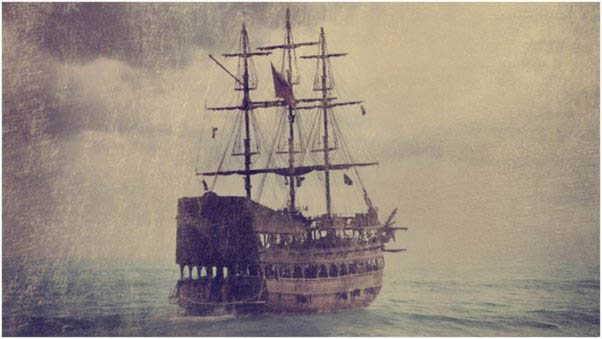Many have heard eerie tales of ships like the Mary Celeste, pushed into popular lore by famous storytellers like Arthur Conan Doyle, but there remains one ship that has strangely slipped beneath the waves of history. The saga of the Octavius is, without a doubt, one of boating’s most underappreciated legends.
The Octavius left London, England in late 1761 destined for Asia. By all accounts, she arrived in good order later the following year. However, for the return trip the captain, bolstered with confidence from unseasonably warm weather, made the decision to attempt the Northwest Passage connecting the Atlantic to the Pacific via the Arctic Ocean in Northern Canada. At that time, no ship had come close to completing the route. At best, it was a hopeless dream. At worst, certain death. With good weather and momentum on their side, the Octavius sailed into the channels of northern Alaska.
The Northwest Passage had long been an ambition for explorers, beginning with Christopher Columbus in 1492, who sought a navigable trade route to Asia without being blocked by North, Central, and South America. But the route was dangerous, so much so that an ice-bound northern route wasn’t discovered until 1850 when Robert McClure used a boat and a sledge to become the first man to circumnavigate the Americas. No ship completed the journey strictly by water until Norwegian explorer Roald Amundson squeezed through five decades later. It took him four years — from 1903 until 1906.
In 1761, the Northwest Passage was a mirage to desperate sailors who had neither the patience to navigate the Americas nor the humility to avoid temptation. Octavius would soon become another victim of hubris.
Flush with confidence, the Octavius entered the labyrinth sometime during the late fall of 1762. She was never heard from again.
On October 11th, 1775, a crew from the whaling ship Herald stumbled upon the Octavius. She was haggard, buried deep in the ice, and silent.
After the men boarded, they found all 28 crew frozen in time. Next to the captain, wrapped in blankets and huddled in the corner, were the captain’s wife and child. They had been locked in place for 13 years.
What makes the Octavius so creepy, so unsettling, is not that she fell victim to the same fate of so many sailors who attempted feats beyond their means. As every sailor knows, Mother Nature holds no temperance. It’s that she might have actually succeeded. But no one will ever know for sure.
When the crew of the Herald checked the master quarters, they found the captain sitting at his desk. Pen in hand. The journal open to his last entry- November 11th, 1762.
For 13 years he hadn’t moved. The last recorded position of the crew while they were still alive was 75°N160°W, which sits 250 miles north of Utqiagvik, Alaska. To understand that significance, Utqiagvik is at the western edge of North America, while Octavius was found west of Greenland, on the eastern side of the Northwest Passage, meaning there was no record of her travels through the Canadian Arctic. But the location of the boat, coupled with the notes in the logbook, indicate that Octavius made it through the Northwest Passage before falling victim to nature. The ship was past the tight channels of Northern Canada. In other words, she had completed the trip — but posthumously.
There is another detail about the Octavius that no historian has been able to confirm – the true identity of the boat. There is a nearly identical story about a ship named Gloriana, found by the Try Again and detailed in a book published in 1905. In that tome, the Gloriana was discovered by Captain John Warrens of the Try Again in 1775. The details of Warrens discovery of the Gloriana are nearly indistinguishable to the Octavius, including the dates in the log book declaring the crew’s last moments. So, which ship was it?
And finally, no historian, explorer, or medical expert has been able to unravel how and why the crew succumbed the way they did. Death by exposure or hypothermia has a typical set of circumstances and symptoms, none of which correlate to the crew of the Octavius. Those near death from the cold do not take their last breaths while sitting at their desk and writing in their journal. The truth, the scientific truth, is that death by exposure is far less aesthetic.
So while details may have been twisted by time, as they often are, the saga of the Octavius is one of boating’s most ominous tales. Perhaps another journal sits on the shelf of a descendent of a sailor with details of the Octavius and how she came to rest in the cold waters of the Arctic. Maybe one day we’ll find out the truth.







